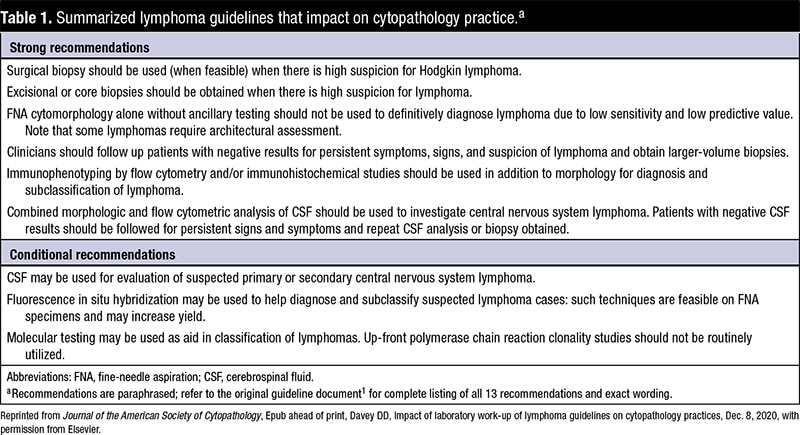Its impact on practice
Christopher J. VandenBussche, MD, PhD
May 2021—The first recommended reading article consists of evidence-based guidelines for the primary diagnosis and classification of lymphoma, formulated by an expert panel convened by the CAP and the American Society for Clinical Pathology and American Society of Hematology.1 A comment period was provided during which more than 900 comments were received for review. The panel members performed a systematic review of more than 700 articles and ultimately identified 42 studies for use in creating their final recommendations. Thirteen guideline statements were created, and the final recommendations were approved by the ASCP and CAP.
One of the guidelines addressed the use of fine-needle aspiration specimens for lymphoma diagnosis, with the panel recommending against the use of cytomorphology alone in these specimens, without the use of ancillary studies, to diagnose lymphoma. Despite its negative verbiage, the guideline does not discourage the use of FNA in triaging lymph node specimens. Diane D. Davey, MD, a pathologist board certified in cytopathology and hematopathology, served on the advisory panel and wrote a commentary on the impact of the guidelines on cytopathology practice, which is the second recommended reading article.2
In her commentary, Dr. Davey notes the challenges of diagnosing lymphomas while relying on cytomorphology alone, especially given the growing complexity in lymphoma diagnosis, which may include more extensive immunohistochemical panels or molecular testing or both. She writes, “The days of classification simply by cell size and shape are past for lymphomas and other types of cancers.” Ironically, the increased need for such ancillary tests can increase the utility of cytology specimens in lymphoma diagnosis. The guidelines provide an example of such a scenario, in which FNA can procure high-yield specimens for FISH testing.
Dr. Davey explains that the guidelines continue to allow FNA to be used for the primary diagnosis of lymphoma with the use of additional ancillary studies. For instance, FNA combined with rapid on-site evaluation is an ideal method for evaluating an enlarged lymph node of uncertain etiology. Material can be obtained quickly for flow cytometric analysis without the need for a more invasive procedure. If an abnormality is identified using cytomorphology or by flow cytometry, the lymph node can be subsequently excised for further characterization, if necessary.

 CAP TODAY Pathology/Laboratory Medicine/Laboratory Management
CAP TODAY Pathology/Laboratory Medicine/Laboratory Management
